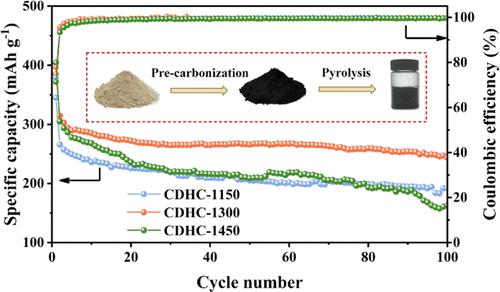当前位置:
X-MOL 学术
›
Energy Fuels
›
论文详情
Our official English website, www.x-mol.net, welcomes your
feedback! (Note: you will need to create a separate account there.)
Electrochemical Behavior of the Biomass Hard Carbon Derived from Waste Corncob as a Sodium-Ion Battery Anode
Energy & Fuels ( IF 5.2 ) Pub Date : 2024-04-03 , DOI: 10.1021/acs.energyfuels.4c00564 Yi Tang 1 , Junwei He 2 , Jiao Peng 1 , Juan Yang 1 , Zhenyu Wu 1 , Peng Liu 1 , Kangjie Zhou 1 , Sihua Hu 1 , Liang Hu 1 , Xianyou Wang 1
Energy & Fuels ( IF 5.2 ) Pub Date : 2024-04-03 , DOI: 10.1021/acs.energyfuels.4c00564 Yi Tang 1 , Junwei He 2 , Jiao Peng 1 , Juan Yang 1 , Zhenyu Wu 1 , Peng Liu 1 , Kangjie Zhou 1 , Sihua Hu 1 , Liang Hu 1 , Xianyou Wang 1
Affiliation

|
Biomass-derived hard carbon exhibits remarkable potential as an anode material for sodium-ion batteries (SIBs) owing to its inexpensive cost, availability of resources, and excellent electrochemical performance. However, the relatively low initial Coulombic efficiency (ICE) significantly confines the realistic application of hard carbon anode materials in SIBs. In this work, corncob-derived hard carbon (CDHC) materials were synthesized from biomass waste corncob. It has been found that the interlayer spacing of the synthesized hard carbon material is greater than 0.37 nm, which clearly surpasses the layer spacing of graphite. This larger layer spacing is favorable for the intercalation and deintercalation ability of sodium ions during the charging and discharging processes. When CDHC is applied by the anode of sodium-ion batteries, it shows excellent sodium storage performance, with a maximum reversible capacity of approximately 311 mAh g–1 and the first Coulombic efficiency close to 80%.
中文翻译:

废玉米芯生物质硬碳作为钠离子电池负极的电化学行为
生物质硬碳由于其低廉的成本、资源的可用性和优异的电化学性能,作为钠离子电池(SIB)的负极材料表现出巨大的潜力。然而,相对较低的初始库仑效率(ICE)严重限制了硬碳负极材料在SIB中的实际应用。在这项工作中,以生物质废弃玉米芯为原料合成了玉米芯硬碳(CDHC)材料。研究发现,合成的硬碳材料的层间距大于0.37 nm,明显超过石墨的层间距。这种较大的层间距有利于充放电过程中钠离子的嵌入和脱嵌能力。 CDHC应用于钠离子电池负极时,表现出优异的储钠性能,最大可逆容量约为311 mAh g –1,首次库仑效率接近80%。
更新日期:2024-04-03
中文翻译:

废玉米芯生物质硬碳作为钠离子电池负极的电化学行为
生物质硬碳由于其低廉的成本、资源的可用性和优异的电化学性能,作为钠离子电池(SIB)的负极材料表现出巨大的潜力。然而,相对较低的初始库仑效率(ICE)严重限制了硬碳负极材料在SIB中的实际应用。在这项工作中,以生物质废弃玉米芯为原料合成了玉米芯硬碳(CDHC)材料。研究发现,合成的硬碳材料的层间距大于0.37 nm,明显超过石墨的层间距。这种较大的层间距有利于充放电过程中钠离子的嵌入和脱嵌能力。 CDHC应用于钠离子电池负极时,表现出优异的储钠性能,最大可逆容量约为311 mAh g –1,首次库仑效率接近80%。





















































 京公网安备 11010802027423号
京公网安备 11010802027423号